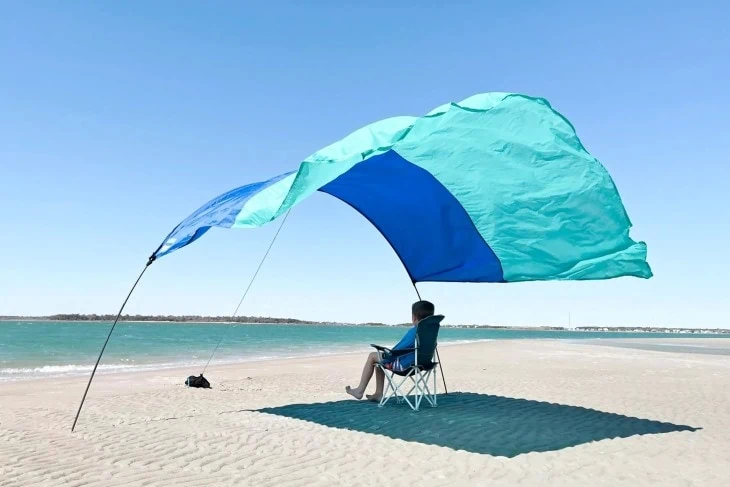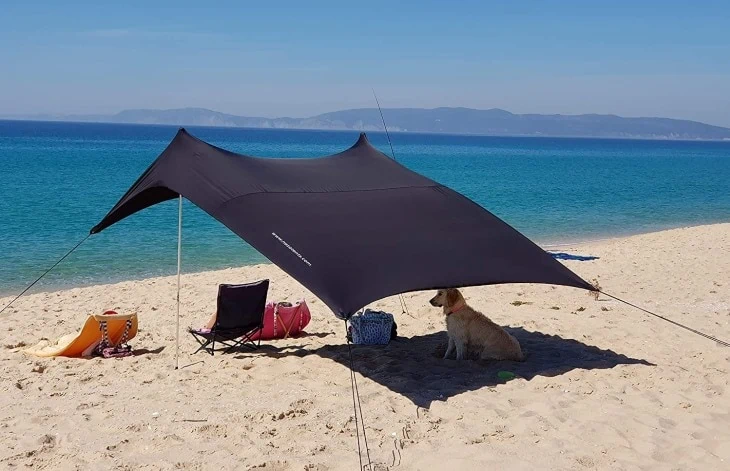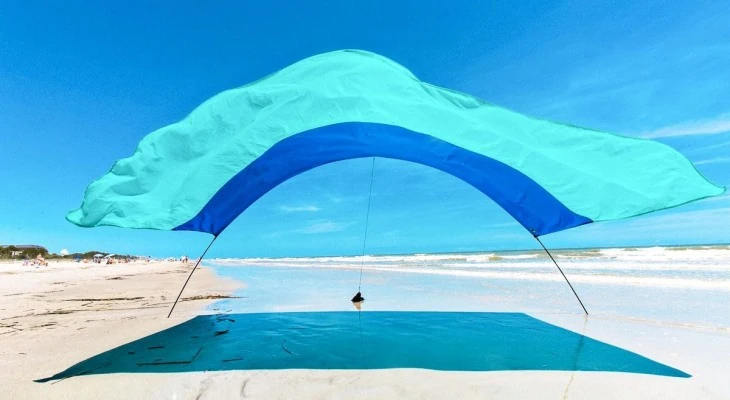Beach shade canopies are an essential accessory for beach lovers. Vital for protection from the sun’s rays, strong winds, wayward sand and pesky sea birds.
There’s the popular Shibumi Shade – famous for its unique design and innovative use of the ocean breeze which works in tandem with the wind instead of fighting against it.
While Shibumi Shade remains a popular choice among beachgoers, its cost can put off enough people. There are many other reliable canopies, including Shibumi Shade knockoffs and other alternatives that can range from $50 to $300 depending on the size, design, and weight of the product.
I’ve featured a few of those in this article so that you can choose one according to your specific requirements and budget.
Table of Contents
What is a Shibumi Shade?

The Shibumi Shade is a very lightweight wind-powered shade canopy made from recycled bottles that were destined to end up as ocean trash.
The Shibumi Shade is a unique concept, designed to stay floating with winds of only 3mph and with no solid structure needing to be transported about, the Shibumi Shade has revolutionized the way beachgoers use a sun shade.
Why is the Shibumi Shade So Popular?
Traditionally, shade canopies have been bulky, difficult to maintain, and unreliable.
The Shibumi Shade aims to tackle some of the major flaws in other canopies and has grabbed the attention of many people through its unique wind-powered design, as well as being lightweight, easy to transport, and sustainable for the environment.
The Shibumi Shade does everything it needs to do. It is a sturdy canopy using connecting poles and sandbags to ensure it does not blow away in high wind conditions. It also provides 150 square feet of shade and offers consistent protection from the sun, ideal on a warm day out at the beach.
However, the Shibumi shades come with hefty price tags of close to $300 for the standard size and nearly $200 for the mini version. It’s likely more than what you’ll be comfortable spending on a beach canopy that you won’t use every day.
There are some beaches in the US where there’s a blanket ban on canopies. This is done mainly to maximize the utilization of the space to allow more people to be there.
But in a few specific locations, such as the Ocean Isle Beach in North Carolina, the rule has an exception such that space-saving canopies like Shibumis are allowed. This makes them even more popular in such locations.
Shibumi Shade Alternatives & Knockoffs

Given the high price of the Shibumi Shade, it’s only natural that you’re looking for more affordable alternatives to it that’ll still get the job done.
Also, for beaches other than ones with a constant breeze, it falls short as it’s entirely wind-powered, so you may need something different for those use cases.
Neso Tents provide adequate levels of shade and sun protection while remaining lightweight and easy to pack up and transport. One potential downside is that they provide you with only two poles, and if you want two more, you’d have to purchase them separately for around $30.
This won’t be an issue on windy days, but on days when there’ll be hardly any wind, you might struggle to keep sections of this tent from touching and falling on your stuff placed under it.
On the plus side, I’ve used this on the hottest of days, and the sun protection that it offers is absolutely top-notch.
The Red Suricata family beach tent is a larger-sized shade canopy, ideal for bigger families or for those who like a little more room. Again, this shade proves to be a lightweight design that is easy to set up and take down.
It has a few more connecting poles than some of its competitors, making it sturdier and less likely to cause any issues in bad weather conditions.
Need a more sheltered type of canopy? Then the Easthills Beach Tent could be the answer.
Unlike the Shibumi Shade, this beach tent has more protection, opting for an enclosed rear but still offers a large family space with an open space at the front to relax and enjoy while catching some rays.
What Makes a Good Beach Shade?
Now that we’ve discussed several shade canopies and how they can help improve your experience at the beach, you may find it tricky to differentiate between each one to find which is the best.
Let’s take a look at a few key factors you will want to consider before purchasing your canopy.
Portability
Buying a bulky, heavy, and difficult-to-transport canopy will present you with endless issues, especially during busy days at the beach.
Check the dimensions and weight of the canopy before you purchase. A lightweight design will allow you to transport it to and from the beach easily. Many can be packed away in a suitcase if you are using them while in another state or country and need to take them home on the plane.
Check the Size

Choose a canopy that is too big, and you will find yourself in too much shade, and a larger surface area is more likely to encounter issues with the wind.
However, choosing a shade that is too small for your needs may result in inadequate coverage from the sun.
Price
A quick search will uncover both premium products as well as much cheaper options, and it’s your job to figure out which one fits your budget while meeting your needs.
If you’re specifically looking for Shibumi alternatives, however, it’s likely that you’re looking for cheaper options that are still decent in terms of quality. In that case, you can consider some of the options I’ve listed above.
You need to consider how often you will use the product. Are you going to use the shade once a year? Then buying a premium-priced product may not be the best option.
However, if you spend time at the beach every few weeks, then you are likely to use the shade more often and therefore get more value out of the product for your money.
Final Thoughts
If the Shibumi Shade doesn’t fit your needs or budget then you won’t be stuck for choice when looking for an alternative.
You’ll be surprised at the range of canopies on the market that offer almost the same experience. Going for the most expensive and largest shade canopy might not always be the most sensible option.

